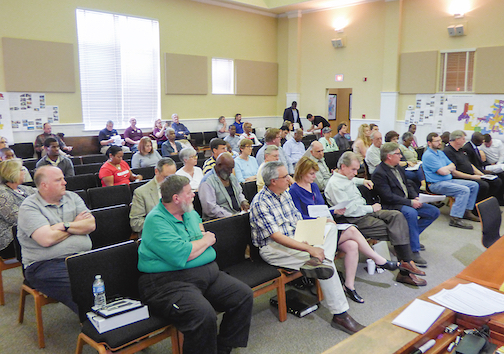
The final public meeting for the Fayetteville 20-year Comprehensive Plan was held March 27 and was months in the making, with input from hundreds of residents. The plan will be presented to the City Council on April 6. So what does it say?
Boiled down: Get more people living within walking distance of downtown, provide more parking, increase the walkability of the downtown, build more parks and fountains, develop “workforce” housing, and attract more active, outdoor-loving and family-oriented residents.
Community goals and the strategies for achieving those goals include the areas of transportation, housing, economic development and land use.
Housing contains two goals. Those include:
• Get more people living downtown to support businesses
Several strategies associated with the goal include actively recruiting mixed-use developers, allowing apartments downtown only as part of mixed-use development and have mixed-use buildings come with first floor commercial or office space. Other strategies would encourage townhouse development oriented toward the street and neighborhood and encourage the development of single-family homes within walking distance to downtown amenities.
• Encourage development of housing for every step of the life cycle
Two of the strategies would investigate ways to promote workforce housing, especially for city employees, and encourage Americans with Disabilities Act accessible and visitable housing units. Another strategy involves addressing the identified need for smaller single-family detached homes with a higher architectural design standard locate in walkable, mixed-use environments. Those developments should be limited outside the downtown area so as not to reduce the demand downtown.
Economic Development contains four goals. Those include:
• Attract people to live here who appreciate an active, outdoor, family-oriented lifestyle, who embrace a sense of community and who are part of an educated workforce needed to fill the jobs we want to attract.
The strategies for this goal include reconsidering city standards for required open space set aside for all zoning districts and to create a green ribbon of parks and trails that connects the entire city.
• Develop a downtown plan to create a unique destination in downtown Fayetteville
Strategies include working with consultants on economically-feasible development strategies and creating a comprehensive marketing plan for downtown.
• Business retention and expansion
The strategies include working with existing businesses and with the Fayette County Development Authority (FCDA) and the Fayette Chamber of Commerce. Other strategies include fostering partnerships between Fayette County schools and local post secondary schools to the support workforce needs of local businesses and encouraging educational enhancements to attract people to the city.
• Business attraction and recruitment
Central to this goal is the development and initiation of a city branding campaign. Other strategies deal with providing incentives for green buildings, investigating a city-sponsored business incubator, working with FCDA, the Chamber and schools to foster relationships for workforce development.
Transportation contains four goals. Those include:
• Participating in the Fayette County Transportation Plan
The lengthy set of strategies for meeting the goal includes items such as creating a grid street network, supporting a more walkable downtown area and pursuing state and federal funding for identified transportation priorities.
• More multi-use paths
Strategies include participating in the Fayette County Trails Plan and developing a Fayetteville Trails Plan.
• Develop a more cooperative relationship with the Ga. Department of Transportation to help meet local objectives for state-controlled roads
The strategies include improved and additional wayfaring signage and pedestrian improvements such as crosswalks and signals.
• Continue progress of making downtown more walkable
Containing multiple strategies, the city would utilize shorter blocks to increase walkability, enhance the pedestrian experience in downtown commercial and mixed-use zoning districts, develop a downtown streetscape plan, add more downtown parks and fountains to enhance the pedestrian experience and provide more downtown parking and signage.
Land Use contains four goals. Those include:
• Improve the property tax base
Strategies include pursuing more business park development, pursuing the goals of the city’s economic development plan and investigating the development of more Tax Allocation Districts.
• Improve aesthetics
The strategies include having more parks, street trees, median landscaping and landscaping at gateway areas. Other strategies include continuing high architectural and site design standards, revisiting the sign ordinance for temporary signs and updating the zoning ordinance to address code enforcement “gray areas.” Two final strategies include adding public art, increasing code enforcement activities and the consideration of adding an additional code enforcement officer.
• Make downtown Fayetteville more vibrant and walkable
This goal comes with a wealth of strategies.
One strategy pertains to getting more people to live downtown. Recommendations include allowing apartments only in the downtown area, encouraging the development of townhouses oriented toward the street, encouraging the development of mixed-use buildings with commercial downstairs and residential upstairs and encouraging single-family homes within walking distance to downtown.
Another strategy involves amending zoning to address mixed uses and to address historic inspiration for new structures. A third strategy would recruit more businesses downtown.
A fourth strategy would add more parking and outdoor event space while a fifth would study the feasibility of a water feature. Additional strategies would locate new civic buildings downtown, add wayfaring signage, make pedestrian improvements in the downtown area and install multi-use trails connecting neighborhoods to downtown.
• Develop or redevelop in accordance with the Future Land Use Map and Character Area Map
Strategies include auditing the zoning map and ordinance for consistency with the comprehensive plan and making amendments to the zoning map and ordinance to encourage and facilitate development and redevelopment.
The comprehensive plan is essentially a policy guide for the city’s growth, development and redevelopment in the coming years, Acting Director of Planning and Zoning Jahnee Prince said at a recent comprehensive plan meeting.
The draft plan is contained in 85 pages, which is available at www.fayetteville.ga-gov and is the result of numerous meetings and surveys in which more than 500 people participated.






